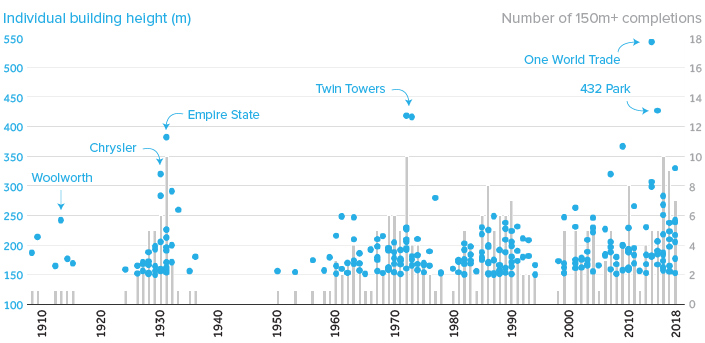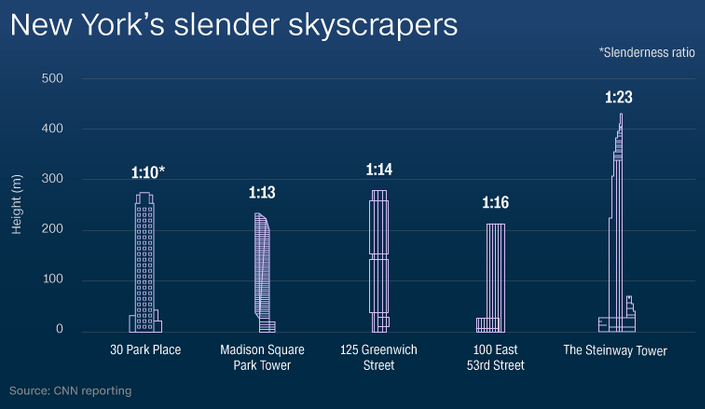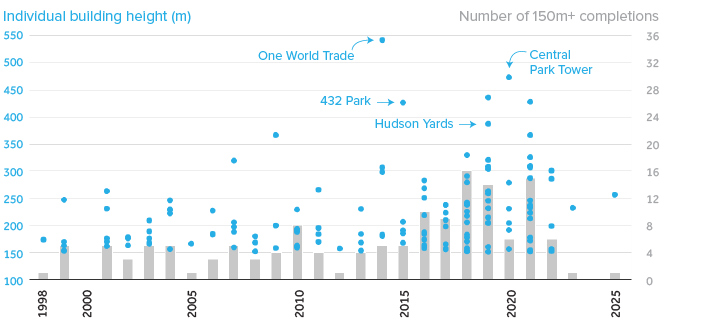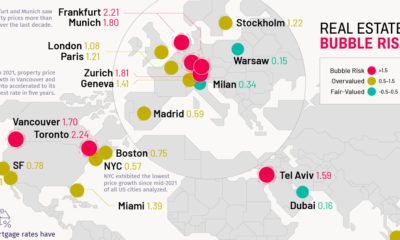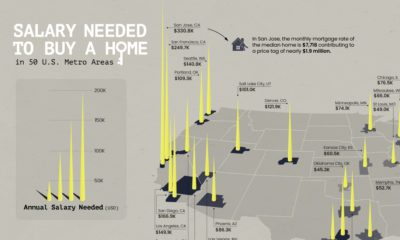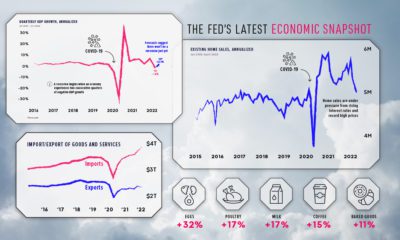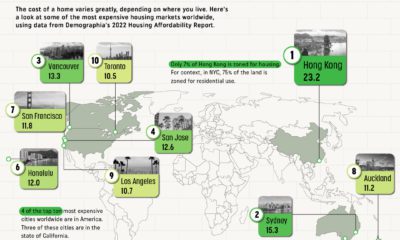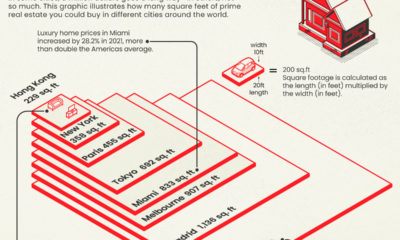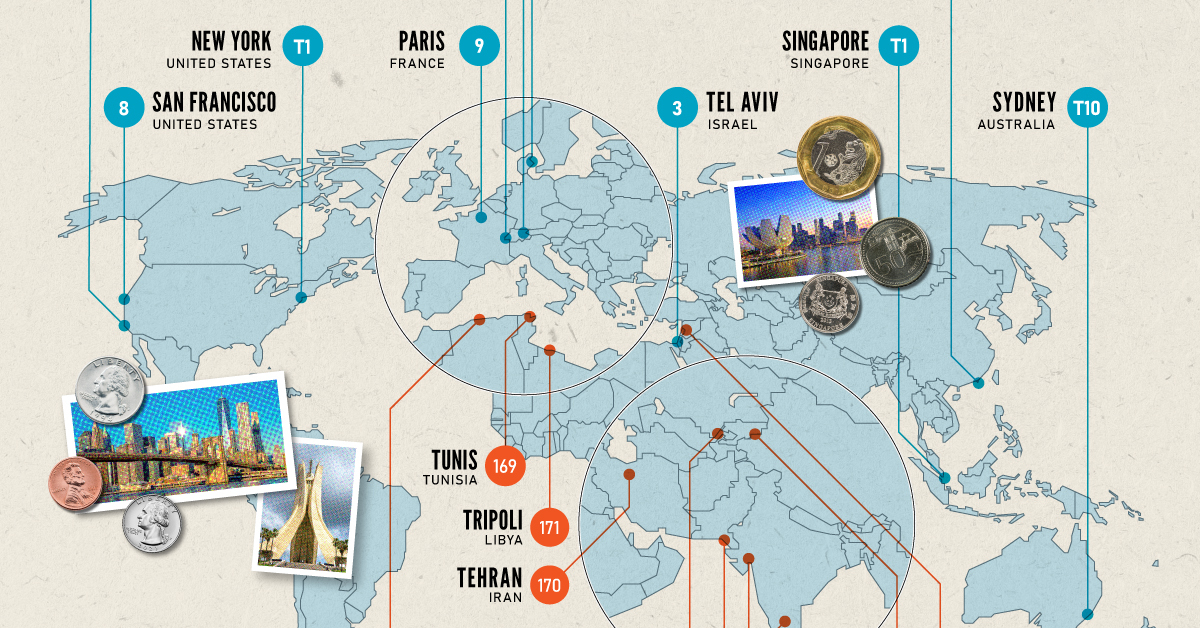Over New York City’s storied history, the skyline has evolved constantly. Smoke stacks and cathedral spires were gradually eclipsed by the stately office towers of “Newspaper Row”, and iconic skyscrapers like the Chrysler Building soon shared the skyline with monolithic towers in the international style. Today’s infographic comes to us from Liberty Cruise NYC and it charts this evolution over the last century, while highlighting just how dramatically the cityscape is set to change by 2020.
The Early History of Skyscrapers
For decades, the ornate spire of Trinity Church towered over Lower Manhattan. It wasn’t until the late-1800s when technology and economic might converged to produce the first modern towers. The city’s first cluster of tall buildings appeared around City Hall, as newspapers competed to see who could build the most grand headquarters. One of the more ambitious projects in this wave of development was the New York World Building (1890), which held the title as the tallest skyscraper in the world. In 1908, the ante was upped further after the completion of the 47-storey headquarters of the Singer Sewing Machine Company and the 50-storey Metropolitan Life Tower. NYC was slower than its rival, Chicago, in adopting skeleton-frame construction techniques, but once that door was open, height records were eclipsed every few years.
From ’20s to zero
The roaring ’20s ushered in a new age of skyscrapers in New York City that only picked up steam heading into the 1930s. Not only was the economy booming, but the United States had recently became one of the first countries in the world to have a majority-urban population. Manhattan was a magnet for growth, and its extreme population density left only one direction to grow: skyward. A number of iconic landmarks were constructed in this era, including the Empire State and Chrysler Buildings.
Source As the chart above clearly illustrates, the onset of the Great Depression had a pronounced cooling effect on construction in New York City. For more than a decade, no new 150m+ towers were added to the city’s skyline.
New York Today
The world has changed a lot since the ribbon was cut in front of the Empire State Building. Flagship skyscrapers have grown taller than we ever could’ve imagined, and relentless development has completely transformed places like Dubai and Shenzhen. Even so, New York City is still home to more 100m+ buildings than any other city on Earth. It’s also worth mentioning that New York City found itself back in the top 10 tallest buildings list after the completion of One World Trade Center in 2014.
What the Future Holds
New York City’s skyline is packed with recognizable towers, but for a long time, few new projects challenged the vertical supremacy of buildings like MetLife or Empire State. Today – thanks to engineering innovations and acquisition of “air rights” on neighboring plots – the skyline is undergoing a dramatic transformation. Powered by a healthy ultra-high-end real estate market, slender skyscrapers are rising above the skyline.
Source This style of building uses a small land footprint so effectively, that projects are springing up around the city. According to Skyscraper Center, there are 86 skyscrapers under construction or planned, with 10 projects set to surpass the height of the Chrysler Building.
While this level of construction is dwarfed by activity in fast-growing metropolises in China, this new generation of high-visibility towers is a sign that the Big Apple is still a strong draw for the world’s ultra-wealthy. on Cities become “expensive” due to a variety of factors such as high demand for housing, a concentration of high-paying businesses and industries, and a high standard of living. Additionally, factors such as taxes, transportation costs, and availability of goods and services can also contribute to the overall cost of living in global cities. The infographic above uses data from EIU to rank the world most and least expensive cities to live in. To make the list, the EIU examines 400+ prices for over 200 products and services in 172 cities, surveying a variety of businesses to track price fluctuations over the last year.
Inflation + Strong Currency = Expensive Cities
If you live in a city where many residents find it challenging to put a roof over their heads, food on their plates, and make ends meet, you live in an expensive city. But if this inflation is compounded with a strong national currency, you may live in one of the world’s most expensive cities. Singapore and New York City tied for the first rank amongst the world’s most expensive cities in 2022, pushing Israel’s Tel Aviv from the first place in 2021 to the third place in 2022. Both these cities had high inflation and a strong currency. Surprisingly, this is the Big Apple’s first time atop the ranking. The city with one of the most expensive real estate markets worldwide, Hong Kong ranked fourth in this list, followed by Los Angeles, which moved up from its ninth rank in 2021.
Poor Economies = Cheaper Cities
Asia continues to dominate the list of the world’s least expensive cities, followed by parts of North Africa and the Middle East. Though affordability sounds good at face value, sitting at the bottom of the ranking isn’t necessarily a coveted position. While the cost of living in some of the cities in these nations is low, it comes at the price of a weak currency, poor economy, and, in many cases, political and economic turmoil. The decade-long conflict in Syria weakened the Syrian pound, led to a spiraling inflation and fuel shortages, and further collapsed its economy. It’s no surprise that its capital city of Damascus has maintained its position as the world’s cheapest city. Tripoli and Tehran, the capitals of Libya and Iran, respectively, follow next on this list, reflecting their weakened economies. Meanwhile, seven cities in Asia with the common denominator of high-income inequality and low wages dominate the list of the world’s cheapest cities. These include three Indian cities, Tashkent in Uzbekistan, Almaty in Kazakhstan, Pakistan’s most populous city of Karachi, and Sri Lankan capital–Colombo.
